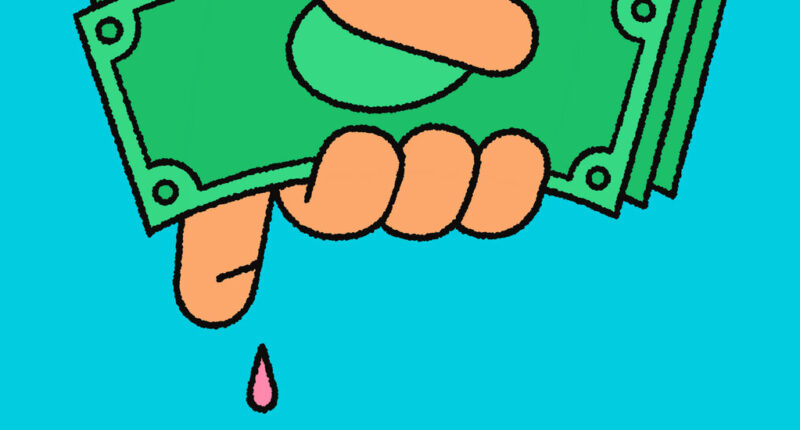
Are the days of overdraft fees almost over?
The dreaded bank fees are shrinking, even as the share of households paying them remains the same, new financial research shows. And banks are increasingly offering their customers alternatives like small installment loans.
Banks charge overdraft fees to cover shortfalls when customers spend more than the amount in their checking accounts. (Banks may also charge “insufficient funds” fees as a penalty when they let a payment bounce.) Once offered as a courtesy, overdrafts grew to become a lucrative source of bank revenue.
But for a variety of reasons, including pressure from regulators, banks have been pulling back from charging the fees. Last year, bank revenue from overdraft and similar fees fell an estimated 6 percent from 2021, to $9.9 billion, and remains “far below” prepandemic levels of about $15.5 billion, according to a report from the Financial Health Network, a nonprofit focused on financial stability.
The typical overdraft fee is $15, half the amount it was two years ago, according to Moebs Services, a financial research firm. (Its calculation is based on more than 3,600 institutions, including banks, credit unions and financial technology companies.)
Experts say several factors besides the scrutiny from financial regulators are behind the drop, including a consumer backlash and competition from new digital money tools. The Consumer Financial Protection Bureau has been scrutinizing fees for financial and other services, and is mulling updates to overdraft rules, leading some banks to make changes.
Other steps that banks are taking to ease the burden of overdraft fees include giving customers a “grace period” of one day to cover a deficit before charging a fee; waiving fees on small overdrafts, like overspending by $5 or $10; and limiting the number of overdraft fees that may be charged in a single day.
“The changes over the past two years are both large and positive for consumers,” said Alex Horowitz, project director for consumer finance at the Pew Charitable Trusts.
While the downward trend is welcome, the share of households with checking accounts that reported paying overdraft fees last year remained unchanged from 2021, at 17 percent, said Meghan Greene, senior director of policy and research at the Financial Health Network.
Banks still collected almost $10 billion in overdraft fees last year, she said, mostly from “people who are struggling financially.” (The network’s estimates for bank overdraft revenue differ from the Consumer Financial Protection Bureau’s numbers because, it said, the bureau’s figures reflect banks with assets over $1 billion, while the network also includes data from small banks and credit unions.)
Financially vulnerable households — those that have trouble paying bills on time, saving for emergencies and managing debt — are much more likely to pay the fees, the network found. Almost half of those households reported paying overdraft fees last year, compared with just 4 percent of financially healthy households.
Vulnerable households, which are disproportionately Black and Latino, are also more likely to report paying more than 10 overdraft fees. Frequent over-drafters are far more likely to say their last overdraft was intentional — meaning they knew they lacked sufficient funds to cover the payment but made it anyway.
“They have very few other options,” Ms. Greene said.
Such consumers are under financial strain from other sources as well, she said. Data from the network’s full FinHealth Spend report, published on Friday, found that total interest and fees from credit card balances rose more than 20 percent last year to an estimated $113.1 billion because of higher card balances and higher interest rates. Almost half of financially vulnerable cardholders have more than $5,000 in credit card debt, Ms. Greene said, meaning the higher rates are adding to the burden on people who are already struggling.
The network’s annual report and the overdraft brief are based on public bank data and a January survey of more than 5,000 household financial decision makers.
Here are some questions and answers about overdraft fees:
Which banks have eliminated overdraft fees?
Many large institutions have done away with fees for insufficient funds, and some banks no longer charge overdraft fees, including Citi, Ally Bank, Capital One and Alliant Credit Union. Other banks that have made changes include Bank of America, which last year cut overdraft fees to $10 from $35.
Some banks no longer allow customers to spend more than they have in their accounts, but instead reject payments that exceed the account’s balance. Others generally allow overdrafts but also offer special accounts that don’t offer the service, for customers who prefer to avoid the potential for fees.
The consumer bureau tracks bank overdraft policies on its website, and financial sites like Bankrate.com also offer lists.
Is there any benefit to having overdraft service?
Some people may want what banks call overdraft “protection,” to make sure important bills will be paid even if an account falls below the necessary balance. Customers must opt in to overdraft for debit and A.T.M. withdrawals. But banks don’t need your permission to charge overdraft fees for online payments or checks instead of letting them bounce.
Consumers have another option. They can link a savings account or line of credit to their checking accounts, so funds are automatically transferred if needed, avoiding an overdraft. Some banks charge a fee when you tap the backup funds, but many have also eliminated such “transfer” fees.
Are there low-cost alternatives for people needing short-term credit?
More banks are now offering automated small loans to their customers. Six of the eight largest banks (based on the number of branches) and seven big credit unions offer such loans, according to Pew. (The greater availability is due in part to guidance issued by financial regulators in 2020.)
The loans range from $5 to $1,000, depending on the bank, and can be far less expensive than relying on repeated overdraft coverage or borrowing from other sources like payday lenders, Pew found. For instance, borrowing $400 over three months from a payday lender typically costs $360 in fees, while banks are charging $24 or less for a loan of the same amount, Pew said.
The loans are considered safer because they are repaid in installments over several months instead of in one balloon payment. Some banks approve borrowers based on their transaction history, rather than their credit score, so customers with low scores who may not qualify for traditional loans can benefit.
Another option: “earned wage access” apps. The apps help workers avoid overdrafting by giving them early access to some of their paycheck to pay bills, said Todd J. Zywicki, a professor at George Mason University’s law school and a research fellow at the university’s law and economics center. “I’m a fan,” he said.
Some consumer advocates, however, advise caution because some apps may charge fees for fast delivery of the money, they said. Some encourage users to pay optional fees based on a percentage of the advance.
Source: | This article originally belongs to Nytimes.com









